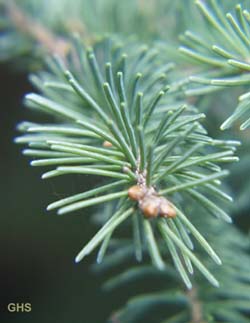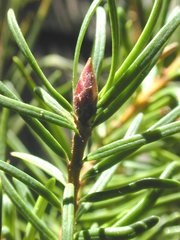Pinophyta
|
|
| Pinophyta | ||||||
|---|---|---|---|---|---|---|
 Close-up of pinophyte leaves (needles): Norway Spruce (Picea abies) | ||||||
| Scientific classification | ||||||
| ||||||
| Orders & Families | ||||||
|
Cordaitales † |
The conifers, division Pinophyta, are one of 13 or 14 division level taxa within the Kingdom Plantae. They are cone-bearing seed plants with vascular tissue; all extant conifers are woody plants, the great majority being trees with just a few being shrubs. Typical examples of conifers include cedars, cypresses, douglas-firs, firs, junipers, kauris, larches, pines, redwoods, spruces, and yews. Species of conifers can be found growing naturally in almost all parts of the world, and are frequently dominant plants in their habitats, as in e.g. the taiga. Conifers are of immense economic value, primarily for timber and paper production; the wood of conifers is known as softwood.
| Contents |
Taxonomy and naming
The current division name Pinophyta derives from the rules of taxonomic nomenclature, which require that the names of higher taxa in plants are based on the name of the type genus, in this case, Pinus (pines). Prior to this, the conifers were commonly known by the scientific names Coniferophyta, Coniferales or Coniferae.
In an older, broader sense of the name, the conifers were often considered equivalent to the Gymnosperms, although this grouping is polyphyletic as it includes distinct, only distantly related plants like the cycads and ginkgos not in the Pinophyta, but excludes the Magnoliophyta (flowering plants), equally or perhaps more closely related.
The division contains just one class of living plants, class Pinopsida. Subdivision of the conifers into two or more orders has been proposed from time to time. The most commonly seen in the past was a split into two orders, Taxales (Taxaceae only) and Pinales (the rest), but recent genetic evidence has shown that this interpretation leaves the Pinales without Taxales as polyphyletic, and the latter order is no longer regarded as distinct. A more accurate division would be to split the division into three orders, Pinales containing only Pinaceae, Araucariales containing Araucariaceae and Podocarpaceae, and Cupressales (including Taxales) containing the remaining families, but there has not been any significant support for any division, with the majority of opinion preferring retention of all the families within a single order Pinales, despite their antiquity and diverse morphology.
The conifers are now accepted as comprising six to eight families, with a total of 65-70 genera and 600-650 species. The seven most distinct families are linked in the box above right and phylogenetic diagram left. In other interpretations, the Cephalotaxaceae may be better included within the Taxaceae, and some authors additionally recognise Phyllocladaceae as distinct from Podocarpaceae (in which it is included here). A further family Taxodiaceae was widely recognised in the past, but is now normally included within Cupressaceae.
The conifers are an ancient group, with a fossil record extending back about 300 million years to the Paleozoic in the late Carboniferous period; even many of the modern genera are recognisable from fossils 60-120 million years old. Other classes and orders, now long extinct, also occur as fossils, particularly from the late Paleozoic and Mesozoic eras. Fossil conifers included many diverse forms, the most dramatically distinct from modern conifers being some herbaceous conifers with no woody stems. Major fossil orders of conifers or conifer-like plants include the Cordaitales, Vojnovskyales, Voltziales and perhaps also the Czekanowskiales (possibly more closely related to the Ginkgophyta).
Morphology
All living conifers are woody plants, and most are trees, the majority having monopodial growth form (a single, straight trunk with side branches). The size of mature conifers varies from less than one metre, to over 100 metres. The world's tallest, largest, thickest and oldest living things are all conifers. The tallest is a Coast Redwood (Sequoia sempervirens), with a height of 112.34 metres. The largest is a Giant Sequoia (Sequoiadendron giganteum), with a volume 1486.9 cubic metres. The thickest, or tree with the greatest trunk diameter, is a Montezuma Cypress (Taxodium mucronatum), 11.42 metres in diameter. The oldest is a Great Basin Bristlecone Pine (Pinus longaeva), 4,700 years old.
Foliage
C_lawsoniana_Lge.jpg
The leaves of many conifers are long, thin and needle-like, but others, including most of the Cupressaceae and some of the Podocarpaceae, have flat, triangular scale-like leaves. Some, notably Agathis in Araucariaceae and Nageia in Podocarpaceae, have broad, flat strap-shaped leaves. In the majority of conifers, the leaves are arranged spirally, exceptions being most of Cupressaceae and one genus in Podocarpaceae, where they are arranged in decussate opposite pairs or whorls of 3 (-4). In many species with spirally arranged leaves, the leaf bases are twisted to present the leaves in a flat plane for maximum light capture (see e.g. photo of Grand Fir Abies grandis). Leaf size varies from 2 mm in many scale-leaved species, up to 400 mm long in the needles of some pines (e.g. Apache Pine Pinus engelmannii). The stomata are in lines or patches on the leaves, and can be closed when it is very dry or cold. The leaves are often dark green in colour which may help absorb a maximum of energy from weak sunshine at high latitudes or under forest canopy shade. Conifers from hotter areas with high sunlight levels (e.g. Turkish Pine Pinus brutia) often have yellower-green leaves, while others (e.g. Blue Spruce Picea pungens) have a very strong glaucous wax bloom to reflect ultraviolet light. In the great majority of genera the leaves are evergreen, usually remaining on the plant for several (2-40) years before falling, but three genera (Larix, Taxodium and Metasequoia) are deciduous, shedding the leaves in autumn and leafless through the winter. The seedlings of many conifers, including most of the Cupressaceae, and Pinus in Pinaceae, have a distinct juvenile foliage period where the leaves are different, often markedly so, from the typical adult leaves.
Reproduction
Largepinecone.jpg
See conifer cones for a more detailed discussion.
Most conifers are monoecious, but some are subdioecious or dioecious; all are wind-pollinated. Conifer seeds develop inside a protective cone called a strobilus (or, very loosely, "pine cones", which technically occur only on pines, not other conifers!). The cones take from four months to three years to reach maturity, and vary in size from 2 mm to 600 mm long.
In Pinaceae, Araucariaceae, Sciadopityaceae and most Cupressaceae, the cones are woody, and when mature the scales usually spread open allowing the seeds to fall out and be dispersed by the wind. In some (e.g. firs), the cones disintegrate to release the seeds, and in others (e.g. the pines that produce pine nuts) the nut-like seeds are dispersed by birds (mainly nutcrackers and jays) which break up the specially adapted softer cones. Ripe cones may remain on the plant for a varied amount of time before falling to the ground; in some fire-adapted pines, the seeds may be stored in closed cones for up to 60-80 years, being released only when a fire kills the parent tree.
TXbaccata.jpg
In the families Podocarpaceae, Cephalotaxaceae, Taxaceae, and one Cupressaceae genus (Juniperus), the scales are soft, fleshy, sweet and brightly coloured, and are eaten by fruit-eating birds, which then pass the seeds in their droppings. These fleshy scales are (except in Juniperus) known as arils. In some of these conifers (e.g. most Podocarpaceae), the cone consists of several fused scales, while in others (e.g. Taxaceae), the cone is reduced to just one seed scale or (e.g. Cephalotaxaceae) the several scales of a cone develop into individual arils, giving the appearance of a cluster of berries.
The male cones have structures called microsporangia which produce yellowish pollen. Pollen is released and carried by the wind to female cones. Pollen grains from living pinophyte species produce pollen tubes, much like those of angiosperms. When a pollen grain lands near a female gametophyte, it undergoes meiosis and fertilizes the female gametophyte. The resulting zygote develops into an embryo, which along with its surrounding integument, becomes a seed. Eventually the seed may fall to the ground and, if conditions permit, grows into a new plant.
In forestry, the terminology of flowering plants has commonly though inaccurately been applied to cone-bearing trees as well. The male cone and unfertilized female cone are called "male flower" and "female flower", respectively. After fertilzation, the female cone is term "fruit", which undergoes "ripening" (maturation).
Life cycle
- To fertilize the ovum, the male cone releases pollen that is carried on the wind to the female cone.
- A fertilized female gamete (called a zygote) develops into an embryo.
- Along with integument cells surrounding the embryo, a seed develops containing the embryo.
- Mature seed drops out of cone onto the ground.
- Seed germinates and seedling grows into a mature plant.
- When mature, the adult plant produces cones.
Other facts
Young_pine_trees_sm.jpg
Although the total number of species is relatively small, conifers are of immense ecological importance. They are the dominant plants over huge areas of land, most notably the boreal forests of the northern hemisphere, but also in similar cool climates in mountains further south.
Many conifers have distinctly scented resin, secreted to protect the tree against insect infestation and fungal infection of wounds. Fossilised resin hardens into amber.
External link
ToLweb: Conifers (http://tolweb.org/tree?group=Conifers&contgroup=Spermatopsida)da:Kategori:Nåletræer (Coniferophyta) de:Nadelholzgewächse et:Paljasseemnetaimed es:Conífera eo:Pinofitoj fr:Pinopsida it:Pinophyta he:מחטנאים nl:Coniferen ja:針葉樹 pl:Iglaste pt:Conífera


